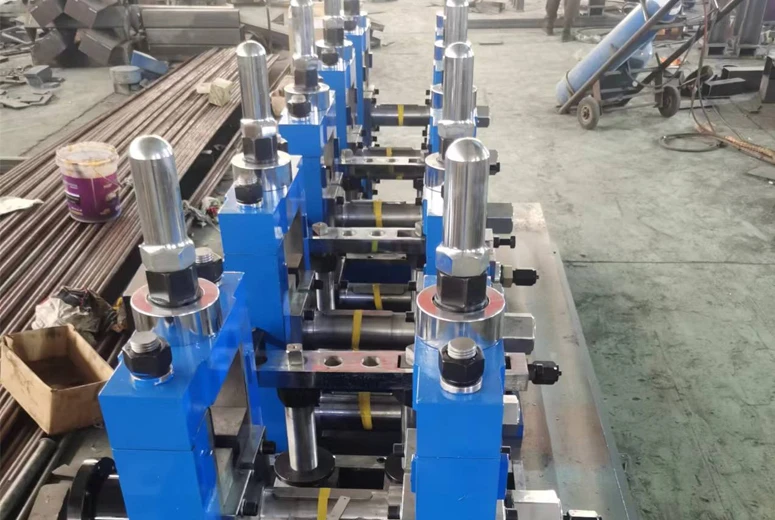roller former
Understanding Roller Formers The Backbone of Modern Manufacturing
In the realm of modern manufacturing, the roller former stands out as a crucial piece of equipment that plays a vital role in producing a wide array of products across various industries. This article delves into the concept of roller forming, its applications, advantages, and how it impacts production efficiency.
What is Roller Forming?
Roller forming is a continuous bending process in which a long strip of metal is passed through a series of rollers. These rollers progressively shape the material into a desired profile. The design of the rollers is tailored to achieve specific cross-sectional shapes, which can include angles, channels, and tubes. This method is particularly effective for metals owing to their malleability and tensile strength, enabling complex shapes to be formed with precision.
The Process of Roller Forming
The roller forming process begins with the selection of the raw material—typically steel or aluminum strips. The strips are then fed into the machine, where they pass through a series of rollers arranged in a sequence. Each roller progressively alters the shape of the strip, guiding it into the desired form. The process is usually set up to run continuously, allowing for high-volume production with minimal waste.
Key components of a roller forming machine include the feeding system, the forming rollers, the adjustable stands, and sometimes a cutting mechanism for inline production. The equipment is customizable to cater to specific requirements, such as material thickness and the complexity of the desired profile.
Applications of Roller Forming
The versatility of roller forming allows for its application across various industries. In construction, it is used to manufacture steel studs, tracks, and roofing sheets. The automotive industry also heavily relies on roller forming for producing parts like structural components and chassis. Additionally, it plays a significant role in creating components for appliances, furniture, and even in the production of decorative elements.
roller former

One of the most significant advantages of roller forming is its ability to produce highly efficient and repeatable results. Because the process is continuous and automated, it minimizes the potential for human error and ensures consistency in product quality.
Advantages of Roller Forming
1. Cost-Effectiveness Roller forming is efficient, using less material compared to other forming processes. The continuous nature of the process allows for high-speed production, resulting in lower labor costs and quicker turnaround times.
2. Precision and Consistency The customization of rollers enables manufacturers to achieve precise dimensions and shapes. This high level of accuracy is crucial in sectors that require detailed specifications.
3. Material Savings Since roller forming generates minimal waste compared to traditional cutting and shaping methods, it promotes sustainability in manufacturing by reducing scrap material.
4. Flexibility The ability to produce a wide range of profiles from various materials makes roller forming adaptable to changing market demands.
Conclusion
In summary, roller forming is a sophisticated and efficient manufacturing process that has transformed the way products are produced across numerous industries. Its ability to produce complex shapes with high precision while minimizing waste and costs highlights its importance in today’s industrial landscape. As technology continues to advance, roller forming machines are likely to evolve, further enhancing their capabilities and applications, making them an indispensable tool in modern manufacturing.
-
High Frequency Straight Seam Welded Pipe Production Line|BzZhou Xinghua|Precision Welding&EfficiencyNewsJul.30,2025
-
High Frequency Straight Seam Welded Pipe Production Line - BzZhou Xinghua|Precision Engineering&EfficiencyNewsJul.30,2025
-
High-Frequency Straight Seam Welded Pipe Production Line-BzZhou Xinghua Machinery Equipment Manufacturing Co., LTD.NewsJul.30,2025
-
High-Frequency Straight Seam Welded Pipe Production Line-BzZhou Xinghua Machinery Equipment Manufacturing Co., LTD.|Precision Manufacturing, High EfficiencyNewsJul.30,2025
-
High Frequency Straight Seam Welded Pipe Production Line-BzZhou Xinghua Machinery Equipment Manufacturing Co., LTD.|Precision Steel Pipe Manufacturing&Industrial EfficiencyNewsJul.29,2025
-
High-Frequency Straight Seam Welded Pipe Production Line-BzZhou Xinghua Machinery Equipment Manufacturing Co., LTD.|Precision Steel Pipe Manufacturing&Industrial EfficiencyNewsJul.29,2025


